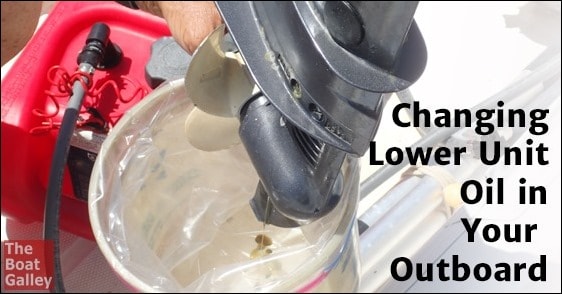How Often to Change Lower Unit Oil

Lower unit oil in boat motors should be changed every 100 hours or at least once a year. Check the manufacturer’s guidelines for specific intervals.
Regular maintenance of boat motors is essential to ensure long-term performance and reliability. The lower unit oil, or gear lube, is a critical component that lubricates internal parts, such as gears and bearings, to minimize wear and prevent failures. As a boat owner, it’s important to adhere to scheduled service intervals, which include replacing the lower unit oil.
This simple yet vital task can save you from costly repairs and unexpected downtime. By keeping up with this aspect of your boat’s maintenance, you can enjoy smoother sailing and peace of mind during your water adventures. Remember to inspect the old oil for metal filings or an abnormal appearance, which could indicate potential problems requiring professional attention.

Credit: www.tohatsu.com
Importance Of Regular Maintenance
Regular maintenance of your outboard’s lower unit oil is crucial. Checking and replacing oil ensures optimal performance and extends engine life.
Changing the oil on time avoids costly repairs. Engine wear and failure are often due to old or contaminated oil. Small investments in maintenance lead to big savings in the long run.
Understanding Lower Unit Oil
The lower unit oil plays a crucial part in outboard engine health. Its main job is to lubricate moving parts, like gears. Without it, parts could wear out fast. This could lead to costly repairs. Regular oil changes keep the engine running smoothly.
Different engines need specific oils. Some oils work best in high-performance engines. Others are for colder environments. It’s key to choose the right oil. The right oil ensures the engine works well. Your engine’s manual can tell you which oil is best.
Signs Your Lower Unit Oil Needs Changing
Maintaining your lower unit oil is crucial for optimal performance of your boat’s motor. You may notice visual clues indicating a change is needed. If the oil appears milky or cloudy, it’s a sign that water has contaminated the oil. This can cause serious damage.
Performance alerts should also be heeded. Difficulty in shifting or unusual noise during operation can suggest old or low oil levels. These issues can escalate if not addressed quickly. Always check your manufacturer’s guidelines and change the oil as recommended to keep your boat in top condition.

Credit: theboatgalley.com
Recommended Change Intervals
Check your owner’s manual for the right time to change oil. Most recommend every 100 hours of use or once yearly. For heavy users, changing oil twice a year is best. Listen to what your boat’s maker says.
Boats used in salt water need more care. Change oil before long storage periods and after. This keeps the engine safe and happy. Think of the weather. Cold may thicken old oil, and heat can stress it out.
Step-by-step Guide To Changing Lower Unit Oil
Before changing lower unit oil, it’s essential to gather the proper tools. You’ll need an oil drain pan, screwdrivers, an oil pump, and the correct oil type. Swiftly and securely drain old oil to avoid spills. Once drained, clean the drain plug before proceeding.
To refill with fresh oil, locate the oil fill hole. Using a pump, add oil gradually until it reaches the fill hole. Don’t rush this step; spills can pollute waterways. Checking for leaks is a must to ensure a job well done.
— Considering the information is more instructional and step-by-step, bullet points might be more suitable. —- Collect all tools and oil needed.
- Drain old oil carefully, watch for spills.
- Clean plug, then begin refilling cautiously.

Credit: www.reddit.com
Troubleshooting Common Issues
Regular maintenance of your boat’s lower unit is crucial. Check for oil leaks often to avoid damage. Spotting oil presence outside the case indicates a problem. Seals may need replacing if leaks persist. Ensure to use the manufacturer’s recommended grade of oil for best performance. High-quality oil protects against wear and corrosion.
Leakage can lead to severe engine issues. DIY fixes can be temporary. Professional assessment ensures long-lasting solutions.
Remember, not all oils are fit for your vessel. Consult your user manual or a professional for the right choice. Using incorrect oil type can cause damage and void warranties.
Frequently Asked Questions Of How Often To Change Lower Unit Oil
What Happens If You Don’t Change Your Lower Unit Oil?
Not changing lower unit oil can lead to increased friction, overheating, and eventual damage to the gears and bearings, resulting in costly repairs.
How Do I Know If My Lower Unit Oil Is Bad?
Check your lower unit oil for a milky appearance, foul odor, or metal particles, all of which indicate contamination or wear. Regular inspections ensure optimal outboard performance.
Does Lower Unit Gear Oil Go Bad?
Yes, lower unit gear oil can degrade over time, necessitating regular checks and replacement to ensure optimal outboard or stern drive performance.
How Often Should You Change Oil In A Yamaha 4 Stroke Outboard?
Change the oil in a Yamaha 4-stroke outboard every 100 hours of use or annually, whichever comes first. Always consult the owner’s manual for model-specific recommendations.
Conclusion
Regular lower unit oil checks are essential for optimal marine engine performance. Aim for a seasonal change, or after 100 hours of operation, whichever comes first. Staying ahead on maintenance preserves your investment and ensures boating reliability. For specific models, consult your owner’s manual and trust a professional if in doubt.
Keep your adventures smooth by changing that oil on time.




